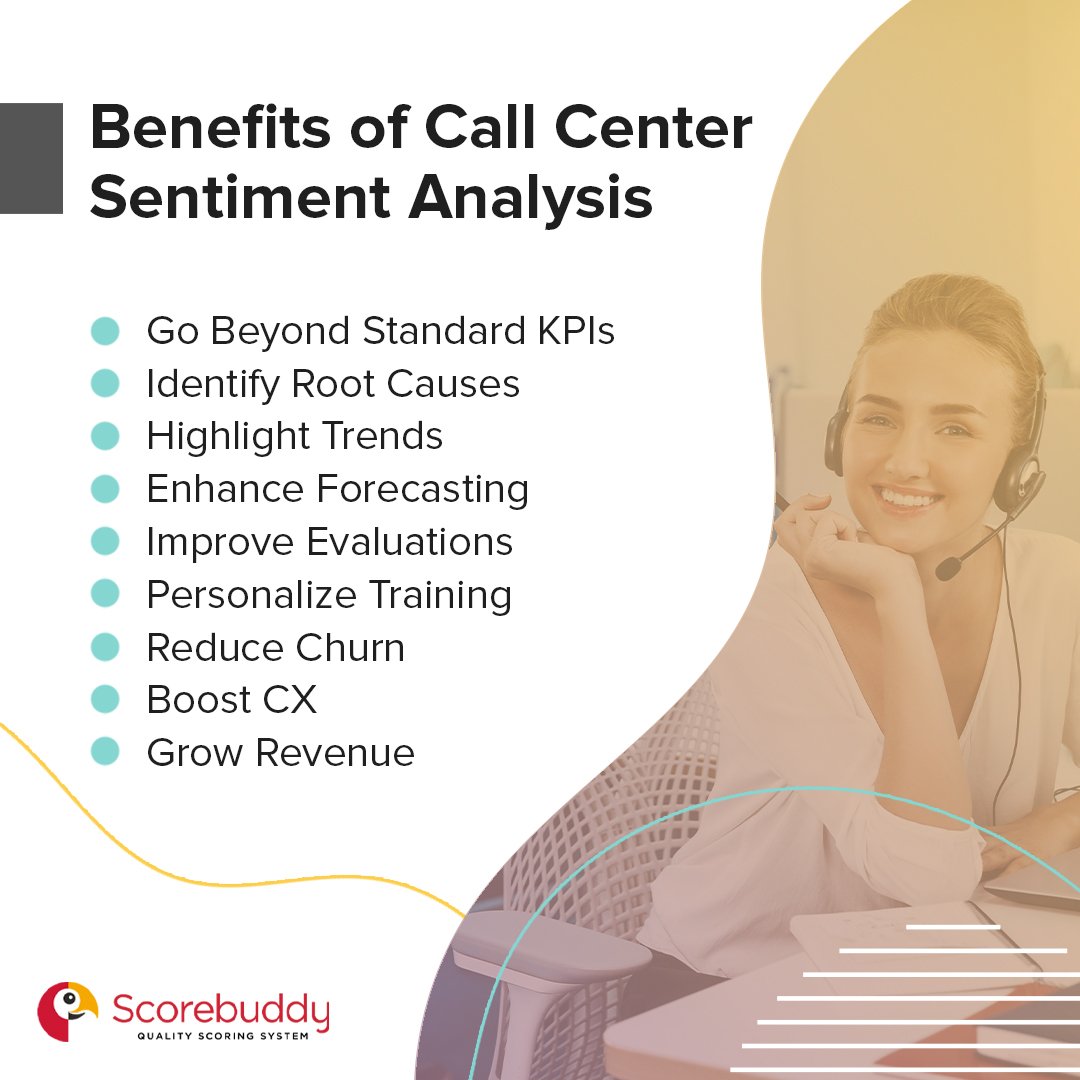Call center sentiment analysis is essential for fully understanding how your customers are feeling. While it may seem quite specific in nature, it can offer insights into many different areas of your organization.
By encompassing all aspects of a customer call, from the words used to tone and verbal cues, you can get a holistic overview of customer experience and satisfaction. It’s the difference between knowing what the customer is saying and actually understanding the meaning behind their words.
For call centers, sentiment analysis is a way of assessing agent-customer interactions and other feedback to understand attitudes, emotions, and opinions towards your brand. In addition to calls, live chat, and other communication channels, you can analyze sentiment from reviews, comments, call center surveys, and more.
In the past, sentiment analysis tools monitored words used in a conversation and defined them as positive, neutral, or negative. With advancements in technology, we now have solutions built on natural language processing (NLP) and machine learning that can analyze vocal inflections and tone in addition to the words used.
The solutions use algorithms to rate sentiment, allowing you to measure it on an individual or group basis, depending on your reporting needs. Beyond the content of the conversation, sentiment analysis can also account for changes in pitch or speaking rate, crosstalk, laughter, interaction length, and more.
With the ability to provide deep insights into customers’ feelings, it’s no surprise that the benefits of contact center sentiment analysis are far-reaching. Effective analysis allows you to stay on top of customer opinion and quickly intervene to address negative sentiment. Let’s look at some of the main benefits.
Traditional call center service metrics like customer satisfaction (CSAT) and Net Promoter Score (NPS) are useful, but their scope is limited. Data for these metrics relies on voluntary responses, and those with strong negative or positive feelings are more likely to respond, skewing your results at the extreme ends of the spectrum.
Sentiment analysis, while providing its own measures, also allows you to contextualize KPIs like CSAT and NPS, so you can develop a better understanding of customer opinion. Additionally, sentiment analysis is automatic. Customers don’t need to opt in, so you get a complete overview of the conversation every time.
Root cause analysis is an important aspect of the quality assurance process for call centers, enabling you to look beyond symptoms and address the underlying causes of customer dissatisfaction. By including sentiment data in your reports, you can improve the accuracy of root cause analysis.
Merging these functions allows you to spot patterns, trends, and correlations you may have missed. For example, you may note that customer retention rates are dropping as negative sentiment increases. By examining the negative calls that lead to churn, it might become clear that your subscription renewal process frustrates customers, driving them away.
Trends in customer sentiment are often indicative of deeper issues in your call center. Effective sentiment analysis allows you to identify recurring queries, common phrases, and differences in sentiment across demographics, regions, and even time of day. By analyzing them, you can inform strategies for improvement.
If the phrase “slow delivery” is a recurring driver of negative sentiment, for example, then it’s clear that something is amiss logistically. Likewise, if multiple customers keep calling to complain about a specific product feature, you can use this feedback to inform your product roadmap.
Tracking past and current customer sentiment isn’t only useful as an exercise in reviewing performance. It can also serve as a forecasting tool. Based on previous trends, you can better plan how to handle future problems in an efficient manner, ensuring that you have the necessary resources in place when sentiment turns negative.
If there are certain days or times that are associated with an uptick in negativity, you could make sure to have sufficient staffing to handle this. Similarly, you can flag customers who repeatedly display negative sentiment and ensure that they are routed to specific agents who are best equipped to handle difficult customers.
Quality monitoring is essential for a successful call center, and evaluations are an integral part of this process. Without them, you’re neglecting your most important resource—the agents that drive your contact center every day. Thankfully, sentiment analysis can enhance evaluations.
By analyzing interactions, you can quickly identify calls with negative sentiment and push them to the top of the queue for evaluation. This way, evaluators are better able to prioritize their workload, and your contact center quality monitoring process becomes more efficient.
The more tailored you can make agent training, the more effective and engaging it is. Broad approaches to training can be useful for setting standards and explaining how your organization operates, particularly during onboarding, but a targeted strategy is necessary to really fine-tune performance.
Using sentiment analysis, you can drill down to the individual agent level and pinpoint recurring mistakes associated with negative outcomes. This way, you can create a specialized training program to correct the issue. In contrast, you can also identify top performers and use their conversations as training on how to handle similar situations.
The improved evaluations and agent training noted above aren’t only beneficial in terms of call center performance; they can also serve to improve the agent experience, leading to better retention rates and employee morale.
Using sentiment analysis, you can monitor performance and experience so you know when to step in and offer additional support. Furthermore, you can use it to recognize and reward agents who deliver positive experiences, incentivizing others to follow their example and improving engagement across the team.
We all know the importance of customer experience for call centers, with 70 percent of customers ready to quit a brand because of poor CX. Given these high stakes, anything you can do to enhance CX and deliver a more personalized experience will be valuable for your organization.
By leveraging sentiment analysis, you can spot when the tone is turning negative and take swift action to rectify that. This proactive approach to customer needs will improve satisfaction and cement loyalty. When customers feel understood and valued, they’re more likely to stick around for the long run.
All of the above benefits feed into one of the core aims of any business—generating revenue. Long-term improvements in agent performance and CX, a better understanding of your customer base, and the ability to quickly fix issues will help boost the bottom line.
With AI-powered sentiment tools, you can even monitor customer intent and deliver special offers at the best time to encourage a purchase, enabling stronger upselling and cross-selling from agents.
Sentiment analysis also enables stronger marketing campaigns. When you know what aspects of your brand customers are responding to, both positively and negatively, you can tweak your marketing strategy accordingly.

While the benefits of effective contact center sentiment analysis are clear to see, you’ll need to implement it properly in order to reap these rewards. Let’s look at some of the most important things you can do to enhance the process and ensure optimal results.
While many call center metrics are measured in numbers, sentiment analysis gives you an opportunity to gather more qualitative data, which can offer a different perspective and contextualize your other metrics.
By asking open-ended questions and trusting your analytics solution to do the work, you can give customers a chance to express their thoughts and opinions fully. For example, don’t ask what they did or didn’t like about the call, keep it neutral and just ask what they thought.
Call centers, despite the name, are about a lot more than just phone calls. To get the full picture of customer sentiment, you should go beyond analyzing typical channels like phone, live chat, and email and incorporate data from reviews, surveys, complaints, social media, and more.
By collating all available data, you can ensure more accurate sentiment analysis. This allows you to make decisions with confidence, knowing that you’re supported by detailed reporting. With 78 percent of customers keen to engage on their preferred channel, comprehensive sentiment analysis is key to optimizing their journey at every touchpoint.
There are a number of key considerations when choosing sentiment analysis technology for your call center. First and foremost, you must determine the unique needs of your business, whether it’s identifying customer issues, understanding brand perception, or improving agent performance.
Once you know your aims, it’s time to think about technology. Advanced sentiment analysis tools use NLP and AI to measure tone, vocal inflections, and other intangible data points, giving you more detailed insights into the meaning behind the words. Many also use real-time analytics, so you can generate immediate insights and track changing sentiment.
Your tech stack plays a big part in determining the success of your contact center. Ensuring that your sentiment analysis solution integrates seamlessly within your infrastructure is key. This doesn't only unlock the full power of sentiment analysis; it also enhances your other call center functions.
Used in conjunction with telephony systems, analytics and reporting, and your customer relationship management (CRM) tool, sentiment analysis can automatically update your customer database based on real-time insights. This way, you can address issues before they escalate and keep customers satisfied.
Customer sentiment can inform your approach to agent training and coaching, both individually and on a team level. By examining how agents deal with negative sentiment, you can highlight knowledge gaps, inappropriate language, and other communication issues that turn sentiment sour.
If your sentiment technology supports real-time analysis, you can also monitor live calls and provide agents with support and guidance during the interaction, so they can learn on the job. Don’t forget the other side of the conversation, either. If agent sentiment drops, this could indicate the need for additional employee support.
Directly measuring customer sentiment with bespoke metrics allows you to track and analyze interaction data so you can identify trends and patterns. This is particularly useful for determining the quality of support and resolutions, as sentiment is most likely to reflect how the customer feel at the end of an interaction.
Additionally, sentiment analysis can provide fresh insights into other KPIs. Take average handling time (AHT), for example. An interaction with high AHT will likely be perceived as negative, but sentiment analysis could indicate otherwise. High AHT alongside positive sentiment may show that the agent actually did an excellent job handling a complex issue.
The global average cost of a data breach has increased by 15 percent over the last three years, highlighting the importance of securing your contact center and ensuring regulatory compliance.
Sentiment analysis provides essential insights for CX, training, and more, but you must take steps to safeguard customer data and ensure their privacy as well. With sentiment analysis offering another perspective on customer calls, you have an even greater overview of agent adherence, enabling quick corrective action in the event of a compliance lapse.
As with any other call center function, ongoing evaluation and iteration is essential if you want to maintain high standards and stay ahead of your competitors. Measure the impact of sentiment analysis—and your resulting decisions—to ensure that you are making progress and getting the best value.
This could mean altering your approach based on previous insights, adjusting the priority of sentiment in relation to other KPIs, or even switching to a new solution as technology develops and the market changes. Whatever it is, make sure your approach to sentiment stays aligned with your business aims.

If you want to really understand how your customers feel, sentiment analysis is essential. Done correctly, it can teach you about agent performance, customer experience, brand perception, and more.
To get the most out of sentiment analysis, you need the right technology in place. Scorebuddy uses advanced analytics, business intelligence, custom scorecards, and more to support sentiment analysis. See for yourself—get a free 14-day trial now.